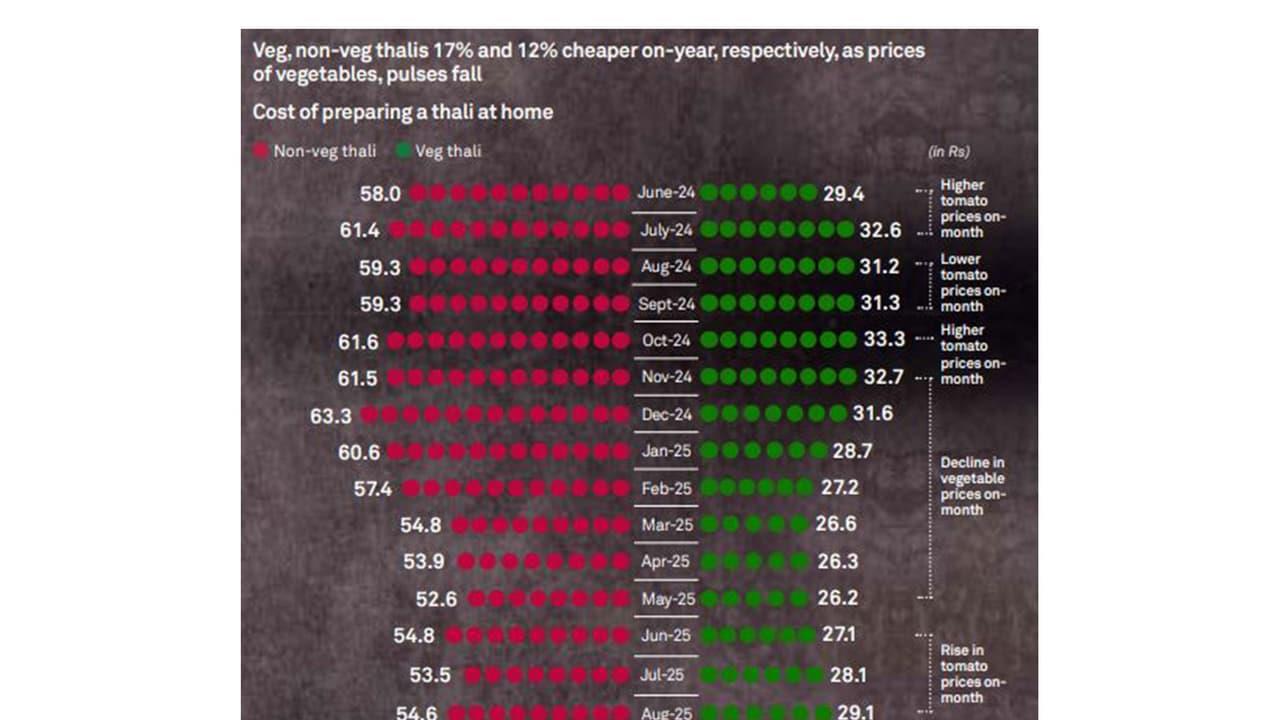
Veg, Non-Veg Thali Costs Dip In October On Cheaper Vegetables: Crisil
Costs of home-cooked vegetarian and non-vegetarian thalis declined 17 per cent and 12 per cent year-on-year in October, respectively, primarily because of a steep decline in the prices of vegetables and pulses, according to Crisil Intelligence's latest Roti Rice Rate (RRR) report.
Reasons for Year-on-Year Decline
The decline in the cost of vegetarian thali was led by a sharp drop in the prices of onions, potatoes, and pulses, as per the report. Potato prices slid 31 per cent on a high base wherein production in Rabi season 2024-2025 rose by 3-4 per cent year-on-year, while tomato prices fell 40 per cent year-on-year on the back of higher supplies from western and southern markets. Onion plummeted 51 per cent year-on-year for two reasons: higher stock availability from the previous rabi season and subdued exports. "Traders have been offloading the rabi season stocks in anticipation of fresh kharif arrivals in November," the Crisil Intelligence report read.
Prices of pulses fell 17 per cent as imports of Bengal gram (up nine-fold last fiscal), yellow pea (up 85 per cent) and black gram (up 31 per cent) surged.
Factors Limiting the Decline
On the other hand, vegetable oil prices darted up 11 per cent year-on-year owing to higher demand during the festival season. That, and a 6 per cent year-on-year increase in the price of liquefied petroleum gas cylinder limited a further decline in the overall cost of thalis.
Non-Vegetarian Thali Analysis
The cost of a non-vegetarian thali fell relatively less because broiler prices fell a moderate 6 per cent year-on-year. "Broilers account for about half of the thali cost. Lower prices of vegetables and pulses, however, helped bring down the overall cost," the report read.
Month-on-Month Cost Movement
However, month-on-month, the cost of vegetarian and non-vegetarian thalis both fell only 1 per cent and 3 per cent, respectively, in October 2025, it added.
Onion and tomato prices slipped 3 per cent and 8 per cent month-on-month, respectively, helping lower the overall cost of thalis, while prices of other inputs remained largely stable. The decline in the non-veg thali cost was on account of an estimated 4 per cent month-on-month drop in broiler prices amid oversupply.
Broader Economic Context: Retail Inflation
India's retail inflation, as measured by the Consumer Price Index (CPI), has been in comfortable position. The headline Inflation in September 2025 is 1.54 per cent, the lowest after June 2017.
The decline in headline inflation and food inflation during the month of September, 2025 is mainly attributed to favorable base effect and to decline in inflation of Vegetables, Oil and fats, Fruits, Pulses and products, Cereal and products, Egg, Fuel and light etc.
Retail inflation data for October is due this coming week. (ANI)
(Except for the headline, this story has not been edited by Asianet Newsable English staff and is published from a syndicated feed.) Legal Disclaimer:
MENAFN provides the
information “as is” without warranty of any kind. We do not accept
any responsibility or liability for the accuracy, content, images,
videos, licenses, completeness, legality, or reliability of the information
contained in this article. If you have any complaints or copyright
issues related to this article, kindly contact the provider above.


















Comments
No comment